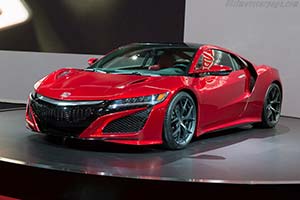
| Honda NSX |
| Article | Image gallery (17) | Specifications |

|
|
Page 1 of 2 Next >> European customer deliveries of the new mid-engine sports hybrid NSX supercar are due to begin in early 2016. Specifically created to bring a "New Sports eXperience" to the supercar segment, the NSX challenges prevailing beliefs about supercars as much as the first generation did a quarter of a century ago. The 2015 Honda NSX is powered by an all-new power unit - a twin-turbocharged 75-degree DOHC V6 engine coupled to a nine-speed dual clutch transmission (DCT) and three electric motors. This Sport Hybrid technology is housed within an ultra-rigid and lightweight multi-material chassis that features world-first material applications and manufacturing processes. As a 'human-centred supercar' that puts the driver first in every aspect of its design, the next-generation NSX will deliver exceptionally intuitive and immediate response to driver inputs thanks to its state-of-the-art hybrid supercar power unit, body and chassis. As the ultimate representation of Honda performance and prestige, the NSX was developed under the theme of 'Precision Crafted Performance'. The development of the 2015 Honda NSX started from a clean-sheet and involved nearly three years of intensive development effort by a global design and engineering team led by engineers at Honda's development centre in Raymond, Ohio. The exterior of the new Honda NSX represents superlative attention to balancing exotic sports car form and supercar function. The development team refer to the result as 'Interwoven Dynamic' design. The body features classic low and wide proportions, sharply contoured surfaces, an aggressive front design, and tail lights that pay homage to the original NSX. The signature side intake and floating C-pillar collects air to feed the mid-mounted engine and directs airflow over the rear deck to increase downforce. To accommodate the new longitudinally mounted engine and transmission the production vehicle was lengthened by 79 mm and widened by 25 mm compared with the NSX Concept first shown in 2013, resulting in a slightly more cab-forward package. Every element of the exterior body design has been carefully fashioned for total airflow management, both for stability-enhancing downforce and vehicle systems cooling. The NSX has undergone extensive testing at the company's state-of-the-art wind tunnel in Raymond, Ohio, leading to a number of significant changes from concept to final body design. These include modified bonnet vents, new front wing vents, modified side air intakes, and an optimised rear spoiler. Consistent with the 'human-centred supercar' development concept, the NSX was designed from the inside out with an uncompromising focus on the driver. Staying true to the legendary original NSX, the newcomer's 'Human Support Cockpit' provides exceptional driver control, visibility and packaging. While the principal endures from the original NSX, the technologies and techniques employed to achieve the objective in the all-new model have advanced immeasurably in order to meet the extreme performance expectations of a modern supercar. The NSX interior boasts exceptional forward visibility, simple and intuitive controls, and class-leading ergonomics. For example, the front seats feature top-class holding performance with outstanding comfort and easy access for the driver and passenger. The NSX's instrument cluster features a dynamic TFT screen that displays various categories of vehicle data and settings according to the selection made by the driver via the Integrated Dynamics System dial control on the centre console. As it controls this powerful driver information hub, it seems entirely appropriate that the Power button that readies the sport hybrid powertrain is located in the centre of the dial. Interwoven under the handcrafted leather dash panel is the exposed mid-frame - a functioning chassis structural member that reflects the design aesthetic of a naked sport bike. An ultra-thin, yet super strong A-pillar design and low-mounted instrument panel minimise obstructions to the driver's view of the road. Page 1 of 2 Next >> |
| Article | Image gallery (17) | Specifications |
| All Cars - Contact us - Privacy Statement - Top | © 1998 - 2024 Ultimatecarpage.com |

